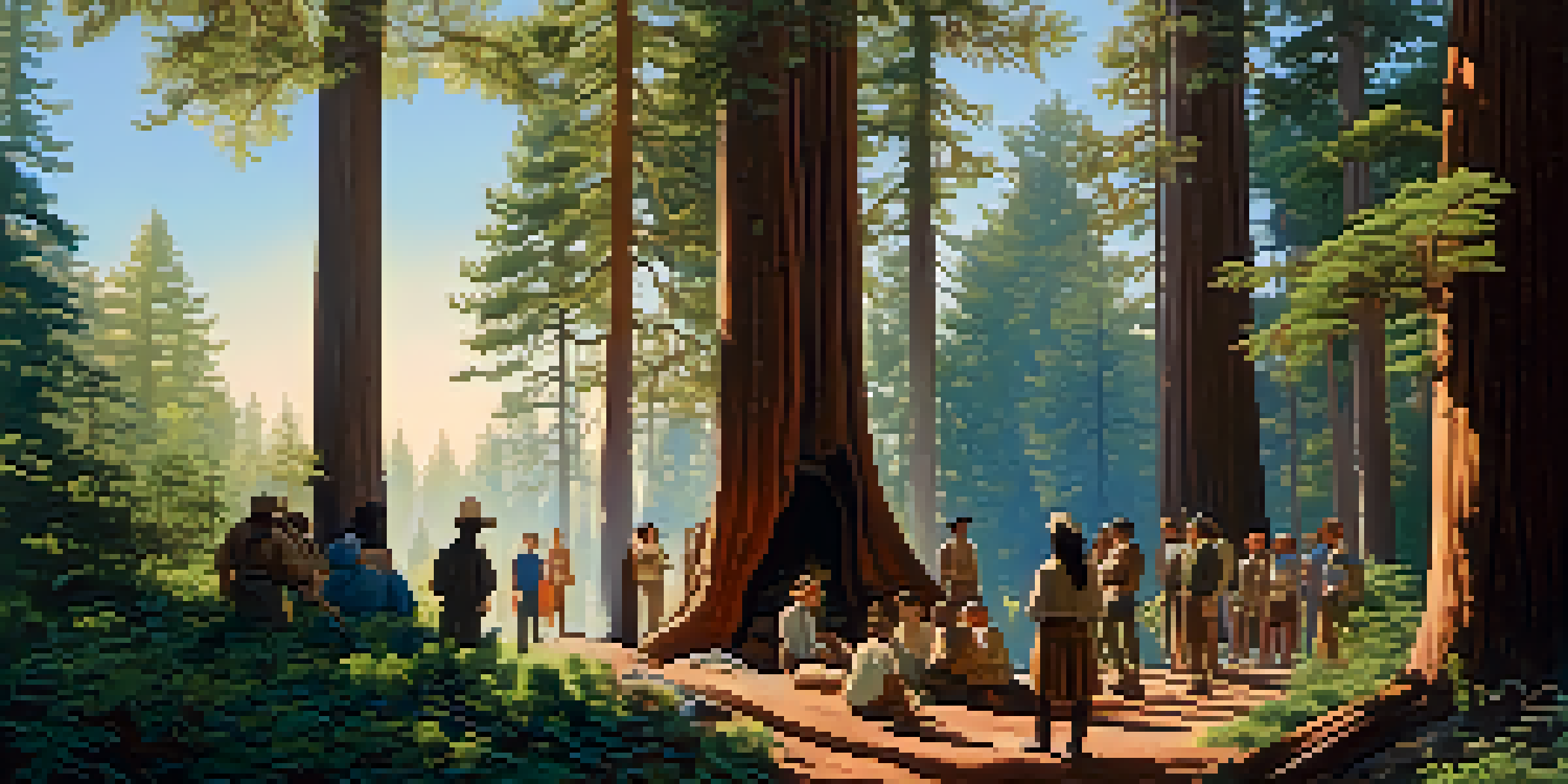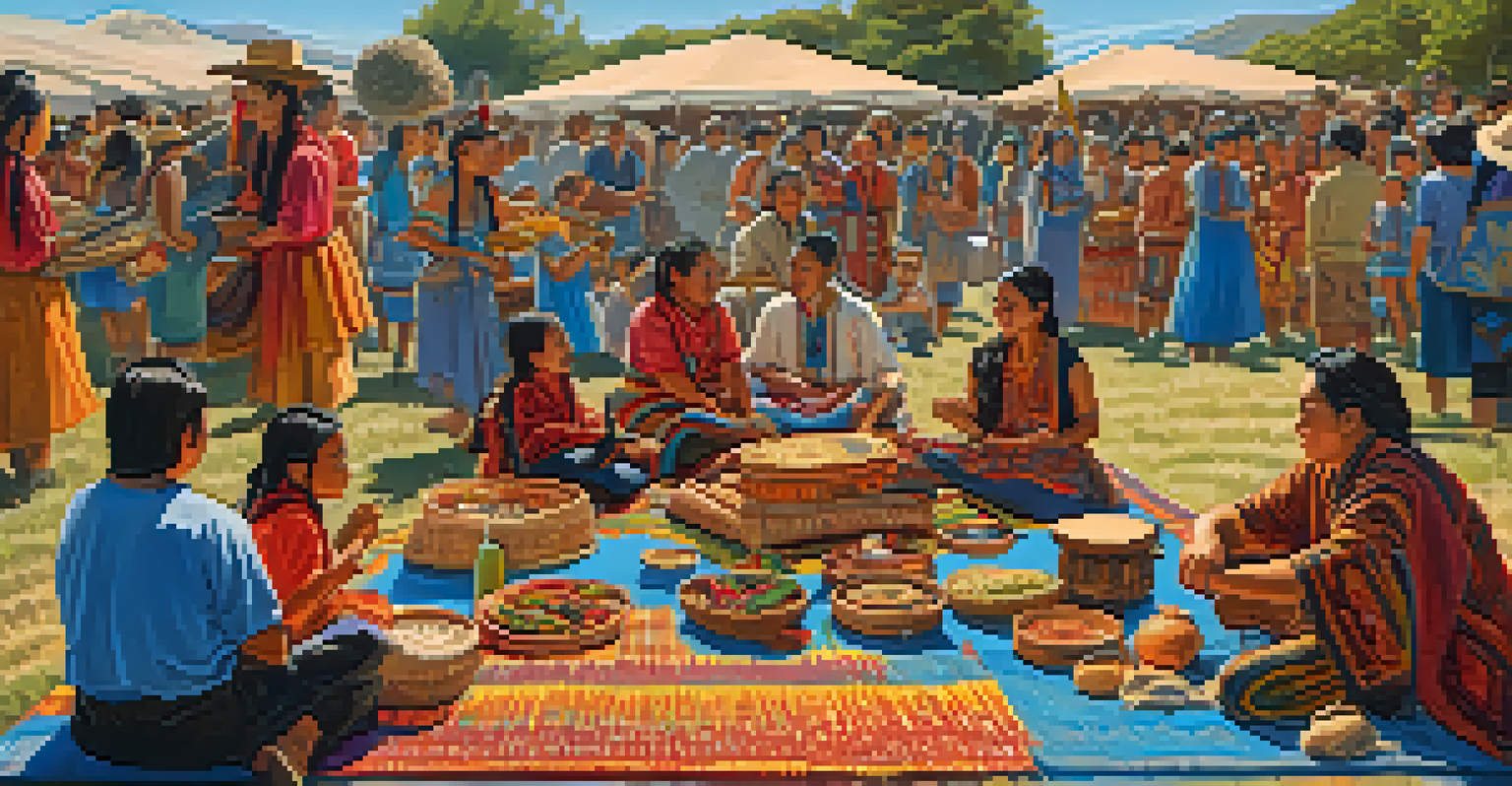The Indigenous Peoples of Redwood City: A Prehistoric Overview

The Land Before Time: Redwood City's Ancient Landscape
Long before modern development, Redwood City was a vibrant ecosystem filled with diverse flora and fauna. The area was characterized by its majestic redwood trees, which not only provided shelter but also served as a resource for the Indigenous peoples. This lush environment offered ample food sources, such as acorns, fish, and game, essential for survival.
The land is alive, with its own spirit and character. It is a living thing, and it is our responsibility to care for it.
The natural landscape was interconnected with the lives of the Indigenous peoples, who had a deep respect for the land. They practiced sustainable living, ensuring that they did not overharvest resources. This relationship with their surroundings was not just practical; it was spiritual, as the land held cultural significance for them.
Through their understanding of the land's cycles, the Indigenous peoples developed a rich tradition of storytelling and oral history. These narratives were often tied to specific locations within Redwood City, creating a sense of belonging and identity that shaped their community.
Who Were the Original Inhabitants of Redwood City?
The original inhabitants of Redwood City were primarily the Ohlone people, a group that thrived along the California coast. They lived in small, semi-nomadic communities, adapting to the changing seasons and availability of resources. This adaptability allowed them to maintain a rich cultural life, relying on both hunting and gathering.

The Ohlone's social structure was complex, with various clans that spoke different dialects yet shared cultural practices. Their society was organized around kinship ties, which fostered cooperation and mutual support among members. This sense of community was vital for their survival in the diverse and often challenging environment.
Ohlone People's Deep Connection to Nature
The Ohlone people's daily life was intricately linked to the natural rhythms of their environment, showcasing their knowledge and respect for the land.
Art, music, and dance were integral to Ohlone culture, reflecting their connection to nature and each other. These cultural expressions were not mere entertainment; they served to reinforce social bonds and transmit knowledge across generations, highlighting the importance of heritage among the Ohlone.
Daily Life and Traditions of the Ohlone People
Daily life for the Ohlone was deeply intertwined with the rhythms of nature. They gathered acorns, wild plants, and hunted game, using tools crafted from stone and wood. This resourcefulness showcased their knowledge of the land and its offerings, allowing them to thrive in a sometimes harsh environment.
Understanding the past is essential for shaping our future, as it informs our identity and our relationship with the land.
Seasonal gatherings brought families together, fostering community connections and sharing of resources. These gatherings often included communal feasts, where traditional foods were shared and stories were exchanged. Such events reinforced social ties and celebrated their cultural identity.
The Ohlone also had spiritual practices that reflected their relationship with the land. They performed rituals to honor the earth and its resources, believing in the interconnectedness of all life. This reverence for nature was a cornerstone of their worldview and guided their interactions with the environment.
The Impact of European Contact on Indigenous Peoples
With the arrival of European explorers and settlers, the lives of the Indigenous peoples began to change dramatically. Initially, there was curiosity and some peaceful exchanges, but soon, the consequences of colonization became apparent. Diseases brought by Europeans decimated populations, as the Ohlone had no immunity to these new illnesses.
Land encroachment further disrupted their traditional ways of life. As settlers claimed territory for agriculture and development, the resources that the Ohlone relied upon became scarce. This loss had profound implications for their culture and social structure, as their connection to the land was severed.
Impact of Colonization on Ohlone Culture
European contact led to devastating changes for the Ohlone, including population decline due to disease and loss of land, which disrupted their traditional ways of life.
Despite these challenges, the resilience of the Ohlone people shone through as they adapted to new circumstances. They engaged in negotiations and sought to retain their cultural practices, demonstrating their determination to survive and preserve their identity amidst adversity.
Cultural Resilience and Revitalization Efforts
In the face of historical challenges, the Ohlone people have shown remarkable resilience. Today, there are ongoing efforts to revitalize their culture, language, and traditions. Community groups and organizations work tirelessly to preserve Ohlone heritage, ensuring that future generations can connect with their roots.
Language revitalization has become a critical focus, as language is a key component of cultural identity. Through classes and workshops, Ohlone descendants are learning their ancestral languages, fostering a renewed sense of pride and connection to their heritage. This initiative not only preserves language but also brings the community closer together.
Cultural events and festivals celebrate Ohlone traditions, showcasing art, music, and storytelling. These gatherings serve as a platform for education and awareness, inviting the broader community to engage with and appreciate Ohlone history. Such efforts highlight the importance of cultural preservation in a rapidly changing world.
Modern-Day Ohlone: Navigating Identity and Community
The Ohlone people today navigate a complex landscape of identity and community. Many individuals identify as Ohlone, even if they do not belong to federally recognized tribes. This sense of identity is often rooted in family history and cultural practices, emphasizing the importance of community ties.
Modern challenges, such as urbanization and environmental issues, continue to impact Ohlone communities. However, many are actively engaged in advocacy, working to protect their rights and the land they cherish. This advocacy is not just about preserving history; it’s about ensuring a sustainable future for their descendants.
Resilience and Cultural Revitalization
Despite historical challenges, the Ohlone community actively works to revitalize their culture and traditions, ensuring that their heritage is preserved for future generations.
Through education and outreach, the Ohlone are raising awareness about their history and contributions. Collaborations with local organizations and schools aim to integrate Indigenous perspectives into broader conversations. This engagement fosters respect and understanding, bridging the gap between cultures and fostering a more inclusive community.
Conclusion: Honoring the Legacy of Redwood City's First Peoples
As we explore the history of the Indigenous peoples of Redwood City, it becomes clear that their legacy is woven into the very fabric of the land. The Ohlone people's connection to their environment, culture, and community continues to resonate today. Understanding this history is essential to appreciating the rich tapestry of Redwood City's past.
Honoring their legacy means acknowledging the struggles they faced and recognizing their ongoing contributions to our society. By supporting Indigenous rights and cultural revitalization efforts, we can help ensure that the voices of the Ohlone are heard and celebrated.

Ultimately, the story of the Indigenous peoples of Redwood City is one of resilience, adaptation, and hope. As we move forward, let us commit to respecting and uplifting their history, creating a future where all cultures can thrive together in harmony.